8 retail trends that will shape the 2021 holiday season

The COVID-19 pandemic saw ecommerce boom during the 2020 holiday season, with sales revenue shattering previous records. Restrictions may be easing, but many new consumers have discovered the convenience and ease of online shopping this past year. So what will the retail holiday season look like in 2021? What retail trends can we expect? And how can your business prepare?
The 2020 holiday season broke records with ecommerce growing 50% to an unprecedented $1.1 trillion global spend between November and December.
In the U.S. alone, at least $1 billion was spent on online retail every single day for the two-month period. That’s a $188.2 billion spend for the holiday season, 32% YoY growth from 2019.
Pandemic restrictions may be easing, but ecommerce is only set to continue its upwards trajectory in 2021. Deloitte predicts another 11-15% increase in ecommerce in the U.S. for the 2021 holiday season. This would see ecommerce holiday sales in America reach between $210 billion and $218 billion.
The shift to ecommerce has been retail’s lifeline during the pandemic. But it also ushered in many changes that we expect to stick around, both in retail operations and customer behavior.
So with the holidays right around the corner, we researched and gathered together 2021’s top ecommerce trends that all retailers should know this shopping season.
What digital transformations are here to stay? What retail industry trends will shape ecommerce in 2021? And what do customers expect from retailers this holiday season?
RELATED: Why Supply Chain Shortages Threaten Ecommerce CX & How to Protect it
1. The future is phygital
With retail stores closed and people stuck in their homes, 2020 was the year retail well and truly went digital. This year, as businesses prepare for the holiday season, 2021 will be the year retail goes phygital.

Phygital retail links the online and offline, facilitating both convenient online shopping and immersive in-store customer experiences. The biggest names in retail are embracing phygital shopping to bring customers back into their stores, from Nike, Amazon, and Target, to Alibaba, Walmart, and Macy’s.
So what does phygital shopping look like? Just some of these big retailers’ phygital innovations include:
- In-store QR codes allowing customers to discover what mannequins are wearing and learn more about products
- Self-checkout and Just Walk Out Technology
- Augmented reality retail apps for use both in-store and at home
- Online inventory checks so customers can check the stock before they head to the store
- Experiential and interactive in-store shopping experiences, such as adjustable lighting in changing rooms and interactive artworks
- Online line monitors, so customers can check how busy stores are, and even book their spot in line so they can wait from the comfort of their homes
There’s a reason the biggest players in retail are focusing on the phygital shopping experience. A recent Shopkick survey indicates that 55% of consumers think the pandemic has changed the way they will shop forever. This means retailers need to change the way they sell.
It’s no longer enough to just offer separate ecommerce and brick-and-mortar stores—the two need to be integrated.
Phygital shopping experiences are drawing customers back into stores, encouraging engagement with brands, and making the customer journey more convenient, smart, and exciting.
How can you use this trend to run seamless seasonal sales?
- Transform the customer experience with phygital omnichannel shopping
- Draw customers back into brick-and-mortar stores this holiday season with experiential and interactive shopping experiences
- Use technology to make shopping more convenient, exciting, and intuitive
2. BOPIS is on the rise
The shift to phygital has been brewing for years now. The most widespread example of this is the rise of buying online and picking up in store (BOPIS), also known as click-and-collect.
In 2019, over 40% of shoppers said they planned to purchase goods online and pick them up in-store, and BOPIS sales grew to $35 billion in America. In 2020, this figure more than doubled, with BOPIS sales totaling over $72 billion—almost 10% of total ecommerce sales. With BOPIS sales forecasted to double again to almost $141 billion by 2024, click-and-collect is here to stay.
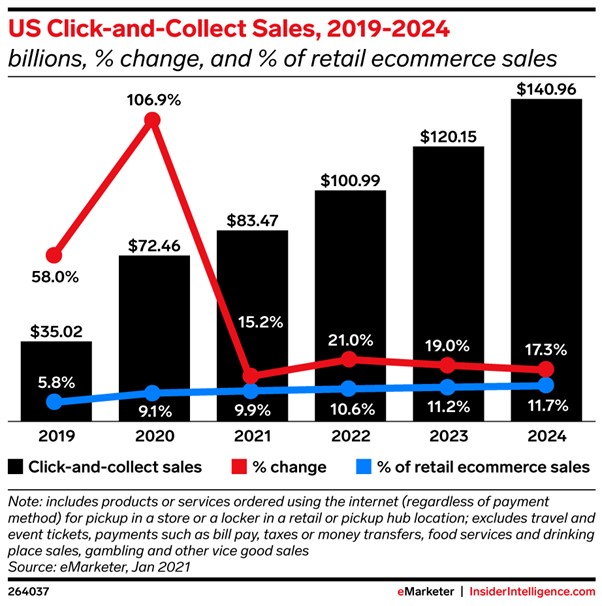
BOPIS is a win-win for customers and ecommerce businesses alike.
Customers get their products faster and save money on shipping. And retailers also enjoy shipping savings, as well as increase their sales by offering customers more ways to buy.
That’s why this year, major retailers like Target and Walmart plan to use BOPIS as an integral part of their holiday season sales.
However, more flexible buying options means many shoppers are delaying purchasing until just days before major holidays like Christmas. In both 2019 and 2020, the peak day for BOPIS was December 23, with customers rushing to get last-minute gifts. This means extra strain on website IT infrastructure, which online retailers should monitor closely during the holiday season.
How can you use this trend to run seamless seasonal sales?
- BOPIS needs to be a part of every retailer’s holiday season arsenal
- Customers choose BOPIS for convenience and speed, so ensure your business has a dedicated BOPIS team, and you follow BOPIS best practices
- Ensure your website is protected against last-minute traffic peaks caused by BOPIS options
3. Mcommerce takes off
Alongside the steady rise of ecommerce, mcommerce is now playing a massive role in online shopping.
The 2020 holiday season saw a $23 billion rise in mobile spending from 2019 in the U.S. In November and December 2020, mobile accounted for 40% of total ecommerce sales. And while smartphones typically have lower conversion rates than desktop shopping, mobile conversions rose 15% in 2020. On Christmas Day, U.S. retailers saw 52% of their online spend come directly from mobile devices—the highest ever for the day!
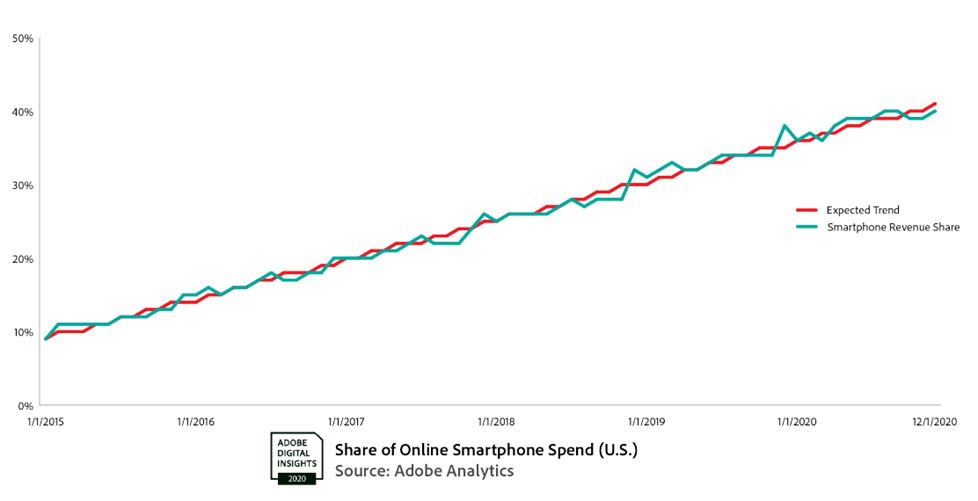
As we’ve mentioned, 2021 for retailers is all about omnichannel shopping experiences. The more opportunities customers are given to conveniently browse and buy, the more they will. App Annie reports that time spent in shopping apps in 2020 grew 45% YoY. And consumers spent $143 billion globally on shopping apps in 2020, a 20% increase from 2019. Even if shoppers aren’t always converting on mobile, it represents a crucial touchpoint in the customer journey for retailers during the holiday season.
Mobile commerce is fast becoming a major player in retail and the ecommerce market. If retailers aren’t catering to mobile and tablet customers, they’re missing out on a major sales opportunity.
The rise in mobile shopping has also led retailers to reconsider how they run promotions and advertisements. There’s a reason mobile ad placements grew 95% from 2019 to 2020. It’s because mobile-first social media apps like Instagram, TikTok, and Snapchat are becoming major drivers of mobile shopping sales.
Walmart, for example, has been betting big on TikTok shopping, hosting live streamed shopping events on the app, collaborating with influencers, and building their TikTok following to an impressive one million users.

How can you use this trend to run seamless seasonal sales?
- Ensure your website is optimized for mobile and tablet users and mobile conversions
- Consider developing bespoke shopping apps to boost your sales and brand
- Leverage mobile audiences by promoting holiday sales and engaging with customers on mobile-first social media apps
4. The shopping holiday season is getting longer
In the past, holiday season shopping was relatively fixed. Holiday shopping began after American Thanksgiving and lasted up to Christmas, encompassing the famous Black Friday and Cyber Monday sales.
In recent years, we’re finding that shopping is no longer limited to this timeframe. In 2021, we tracked 2.54 billion visitors across 97 retailers over the holiday season. We found that online visits spiked at the beginning of November and these numbers stayed high all the way through to December.

Our findings mirror a recent Deloitte survey which found that 61% of shoppers planned to start their holiday shopping before Thanksgiving.
So why is the holiday season getting longer?
Well, it’s because retailers have discovered just how valuable it is to get the holiday season started early and capture sales and customer loyalty while there’s less competition.
Shoppers who began shopping before Thanksgiving last year expected to spend an average of $388 more than those who started after the holiday. What’s more, 42% of Cyber Weekend purchases last year were made by repeat buyers.
Retailers are running their sales, promotions, and shopping events earlier in the holiday season because the customers they reach are likely to make repeat purchases, and they typically spend more.
With major retailers starting their holiday sales early, you can’t afford to miss the first leg of the holiday season race.
How can you use this trend to run seamless seasonal sales?
- Consider starting holiday sales earlier this year to draw in new customers
- Focus on creating an exceptional customer experience to capture loyalty early in the holiday season
- Ensure your website is protected from traffic peaks for the entire holiday season
5. Ecommerce goes cross-cultural
Just as the holiday season is no longer bound to the traditional timeline, region-specific shopping days are quickly going global.
Black Friday already has its foothold in the U.S., the U.K., Australia, and other countries. But the day is becoming increasingly popular in China. American brands and products are seeing a popularity surge over the Cyber Weekend among affluent consumers in some of China’s biggest cities. Top-selling products include cruelty-free cosmetics, health supplements, and mom and baby products.
Black Friday isn’t as well known in China as the more ubiquitous Singles’ Day. But this hasn’t stopped online retailers using the day to draw attention to their brand and products, building a following in the trillion-dollar market.
On the flip side, Singles’ Day is picking up steam outside its original Chinese market. Not only has the shopping event expanded well into Southeast Asia, it’s also gaining traction in western Europe and America. Awareness of Singles’ Day in Europe is on the rise. And many big-name European online retailers have implemented Singles’ Day sales into their seasonal retail campaigns with positive results.

Online retailers need to think outside the box and consider new seasonal sales as part of their holiday season arsenal. Not only can the payoff be big, but they can reach new shoppers, building long-term followings and demand outside their traditional markets.
How can you use this trend to run seamless seasonal sales?
- Take advantage of new international seasonal sales, such as Singles’ Day, Click Frenzy, and Cyber Day to keep the holiday shopping rolling
- Leverage the global reach of ecommerce and the holiday season to target new audiences and build brand awareness in new markets
6. What’s old is new again
Holiday ecommerce trends not only include expanding geographical and time boundaries, but also ideas about gifts. Sustainability has become a major driver of purchase intent in recent years. As a result, the resale market has boomed in 2020, and shows no signs of slowing down.
ThredUp reports that 33 million consumers bought secondhand apparel for the first time in 2020. And 42% of all consumers, and 53% of millennials and Gen Z surveyed said they’ll spend more on secondhand in the next five years.
The resale market is growing fast. It’s expected to double in size to $51 billion by 2023. Apparel rental services are also expected to grow by 20% annually. Because of its popularity, many traditional retailers, including Macy’s and Urban Outfitters, have announced subscription rental services. Meanwhile, other retailers have introduced buy-back programs for their used products, and big companies like Apple are increasingly pushing their trade-in options.
These initiatives are not only more sustainable, they also open new sales opportunities for retailers. Whether it’s customers who only need products in the short-term, customers without the money to buy products new, or those who want to reduce their environmental impact—resale, rental, and trade-in offerings cater to them all.
56% of U.S. consumers surveyed in CGS’s Retail and Sustainability Survey said they would pay more for a sustainable option. What’s more, half of the same respondents also believe that apparel and footwear brands are currently not transparent enough about their practices.
It’s evident year on year that customers are still demanding and willing to pay for sustainable shopping choices. In the lead up to what will be an intense and competitive holiday season, it’s up to the savvy online retailer to find methods to integrate this demand into their business and marketing campaigns to stand out from the crowd.
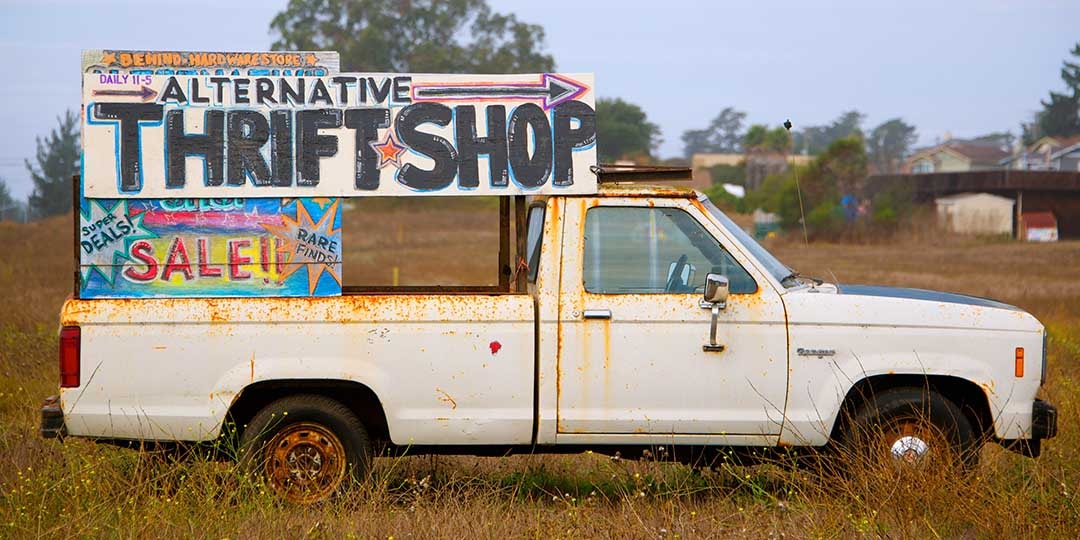
How can you use this trend to run seamless seasonal sales?
- Make sustainability a priority this holiday season
- Consider options such as trade-ins, reselling, and renting items to tap into the ever-growing resale market
7. Customers prize company values
Marketing promotions and advertisements are a part of every online retailer’s holiday season campaigns. However, consumers are subject to many ads from like-minded businesses, especially around the holiday season.
In fact, American consumers are exposed to up to 10,000 ads a day.
It’s frankly not enough to highlight price as a stand-out point. Holiday season sales are built around discounts, and lower prices are a selling point consumers are used to seeing.
So how does an online retailer stick out from the sea of holiday season ads?
By promoting brand values.
Brands like Patagonia have gotten positive press for their decision to donate 100% of their Black Friday profits to grassroots environmental groups. They even ran a Black Friday campaign asking consumers not to buy their jackets, and to instead prioritize sustainability by buying less. REI has famously opted out of Black Friday sales since 2016, encouraging customers to instead spend the day outdoors and exercising.
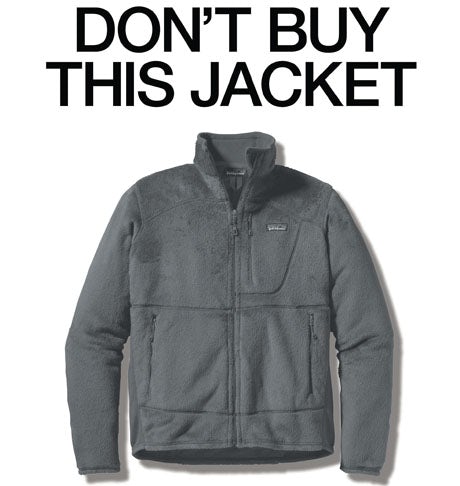
In these especially uncertain times, leading with empathy or directly addressing customers’ concerns helps create consumer trust in a company. Brand trust, more than other factors, influences 70% of customers’ buying decisions. And when a brand can create a feeling of connection, they can form a potentially long-term relationship with customers.
How can you use this trend to run seamless seasonal sales?
- Consider your company’s values and ensure everyone from executives to store clerks are aligned on them
- Foreground your values by enacting genuine change in your business for the holiday season
- Use the extra holiday season attention and web traffic as an opportunity to show what your business stands for
8. IT outages during business-critical online sales
We continue to see big-name retailers every holiday season. A 2021 survey from Contentsquare found that 70% of marketers are concerned about technical issues over the holiday season, with 34% concerned their website or app will crash over the period.
Why are marketers worried about website crashes?
Not only do crashes have the short-term effect of lost sales and more orders on competitor websites, but also long-term effects on brand reputation.
Retailers want to capture loyalty early in the holiday season to ensure repeat purchases over the period. But studies show that 79% of potential customers who encounter poor website performance on their first visit would avoid buying from that website in the future—often jumping to a competitor’s site instead.
Now more than ever, poor website performance is a risk that most retailers can’t take.
Unfortunately, IT outages remain common in online retail. Just last year, Walmart’s holiday season PS5 drop brought the website to a halt.
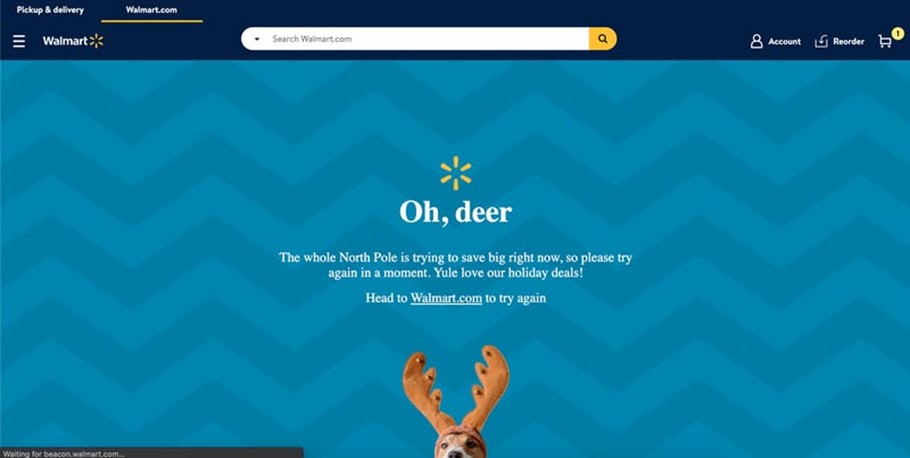
According to a LogicMonitor survey, 96% of global IT decision makers have experienced at least one outage in the last three years, despite the fact 80% of the same decision makers reported IT performance/availability was their biggest concern. What’s more, over half of those surveyed believe these outages were avoidable!
During the holiday season, website downtime often occurs because of traffic surges. In the moment, these surges can seem like the dream for an ecommerce website manager. However, the situation can quickly become a nightmare if websites are not adequately prepared for traffic.
How can you use this trend to run seamless seasonal sales?
- Understand how high online traffic crashes websites
- Optimize the performance of your site by compressing images, minimizing the use of plugins, and using a content distribution network
- Understand your site capacity and bottlenecks by load testing your ecommerce site
- Implement a virtual waiting room to ensure your website stays online and customers are given a fair and smooth ecommerce experience